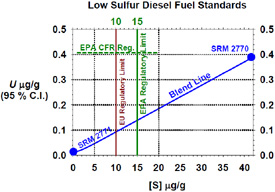NIST has recently certified a new reference material for sulfur in diesel fuel at 0.102 ìg/g ± 0.014 ìg/g (95 % confidence level). This new standard will assist the petroleum industry in meeting the U.S. Environmental Protection Agency's (EPA's) 15 ìg/g (ppm) limit on ultra-low sulfur diesel (ULSD), which took effect on June 1, 2006.
The European Union's upper limit on sulfur in both diesel and gasoline is 10 ìg/g. The ULSD is enabling new after-treatment technology to reduce particulates and NOx in diesel emissions. The EPA estimates that the new highway heavy-duty and 2010 Tier 4 non-road diesel regulations will provide approximately $150 billion annually in health and welfare benefits to the American public when fully implemented.

The primary transportation system for diesel and other refined products in the United States is an elaborate and efficient 200,000 mile underground pipeline system. Maintaining the integrity of 15 ppm diesel fuel by limiting sulfur cross-contamination during pipline transit is a formidable challenge.
SRM 2771 is an ultra-low level diesel fuel blend stock that can be used as a natural-matrix blank to check the near-zero point on calibration curves and as a gravimetrically blended diluent with existing diesel fuel SRMs to prepare calibration standards and check samples. The solid blue blend line in the chart below represents a continuous series of blends with existing SRM 2770. The uncertainty in the blends between 1 ìg/g and 20 ìg/g is well below the accuracy requirement of the EPA.
The accuracy required by the EPA as stated in 40 CFR 80.584 is stated as "the arithmetic average of a continuous series of at least 10 tests performed on a commercially available gravimetric sulfur standard in the range of 1 ppm to 10 ppm sulfur shall not differ from the accepted reference value (ARV) of that standard by more than 0.54 ppm sulfur." The same requirement is also specified for the 10 ìg/g to 20 ìg/g range. If this 0.54 ìg/g requirement were interpreted as 3s limit, then it can be expressed as a 95 % confidence interval of 0.41 ìg/g given by the green dashed line in the figure.